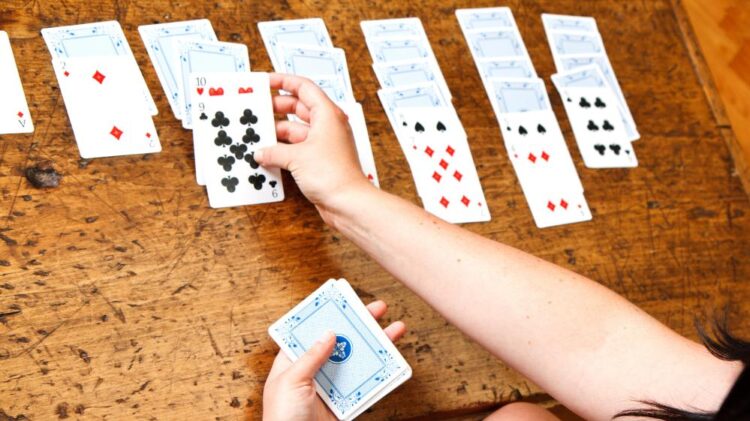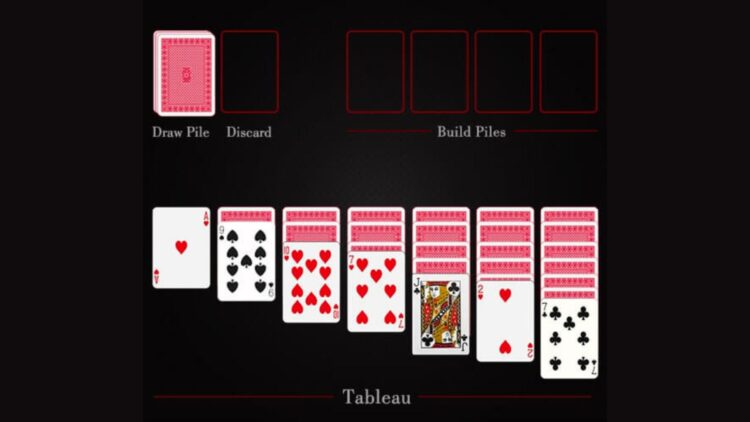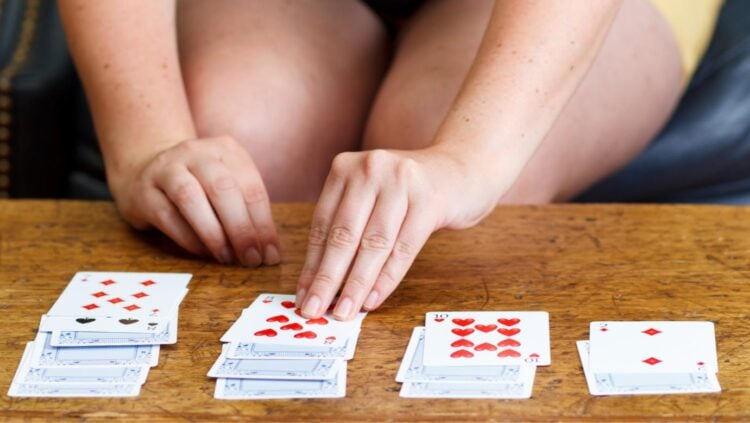
OBJECTIVE OF SOLITAIRE: Move all cards from the tableau and from the stockpile into four build piles.
NUMBER OF PLAYERS: 1 player
MATERIALS OF SOLITAIRE: Standard 52-card deck
TYPE OF GAME: Card game
AUDIENCE: All Ages
OVERVIEW OF SOLITAIRE

Bored and getting tired of screen time? Boy, have we got the game for you! Solitaire is a classic card game for 1 person. And just because it’s only a single person playing doesn’t mean this game isn’t any less fun! In fact, it’s super addicting; take our word for it. To play this game, you simply need a deck of playing cards, and you’re good to go.
There are many MANY versions of Solitaire out there, including Spider Solitaire and Klondike Solitaire, but they all derive from this standard version. Have you always wanted to try Solitaire but you’re not sure how to play? That’s where we come in!
Solitaire may be difficult to play, but it’s pretty easy to understand. You may not win a game in a while, but you’ll be playing in just a matter of minutes! Here are the official rules for Solitaire.
SETUP FOR SOLITAIRE
The setup is incredibly important in Solitaire. Setting up the game can be confusing at first, so read closely!
To start playing, you need to build the tableau or layout. The Solitaire tableau is made up of 7 columns of cards on the table.
THE TABLEAU
Before you start building the tableau, make sure you thoroughly shuffle the deck of cards.
Once shuffled, to make the tableau, first, flip the first card face up on the table. Then, deal another six cards side by side but make sure they are all face down. These cards should all be in line with the first card that was flipped over. This creates the seven columns of playing cards in the tableau.
From there, deal one card face-up on top of the second column (since the first one already has a face-up card). Make sure to put this card a bit lower than the face-down card. Then, again, deal five cards side by side on the remaining columns in line with this second face-up card.
Continue in this manner, with the third card now receiving a face-up card and columns 4 through 7 getting another face-down card each.
Once you are done setting up, the first column should have one card, the second column two, the third column three, and so on. And the final card of each column should be face up. So, for example, column seven should have six face-down cards and one face-up card at the bottom.
THE STOCKPILE, THE DISCARD PILE, AND THE FOUNDATION PILES
The rest of the cards form the stockpile, with an empty space for a discard pile next to it. These cards should remain face-down. Make sure to leave enough space above the tableau for four foundation piles as well.
Pretty confusing, right? Use the image below for reference as to how the initial setup should look.

HOW TO PLAY SOLITAIRE
To understand how to play Solitaire and the Solitaire rules, you have to understand your objective. In this game, your objective is to move cards around the tableau to create complete the four foundation piles from ace to king in a single suit.
The rank of cards is important in this game: K is the highest suit, whereas A is the lowest.
BUILDING
To play Solitaire, you begin by building. Look at all the cards that are face-up in your tableau. You may move any of these face-up cards – and the face-up cards only! However, you can only move these face-up cards if they can feasibly be moved to another column.
To build, you can layer cards of opposite colors on top of each other in descending order. For example, you can move a 9 of spades onto the 10 of hearts.
If you move a face-up card on your tableau to another face-up card in this manner, this means the underlying card from the column where you moved the 9 of spades is now exposed. If a column no longer has a face-up card, flip over the bottom-most card to reveal the card underneath.
Continue consolidating and building in this manner until you run out of moves.
FOUNDATION PILES

At any point, if you find any Aces face-up, move them above your seven columns to start a foundation pile for that suit. A foundation pile starts with an Ace and ends with a King and must be built on in sequential order. Eventually, you should have all four Aces on top of your tableau.
Once you have an Ace on a foundation pile, you can start building on this too. So, for example, if you have an ace of spades on top of your tableau, and you happen to have a 2 of spades face-up in your tableau, you can move this card on top of your ace of spades.
Remember: the goal of the game is to create all four foundation piles. So, you’ll need to eventually put all the cards in the four foundation piles in order from ace to king.
EMPTY SPACES AND KINGS
As you move the cards around, eventually, you may end up with an empty column, as all cards of that column have been flipped over and played. When this happens, according to official Solitaire rules, you can only fill this space with a king.
Moving a king to the empty space gives you another opportunity to unblock another card underneath the king in another column!
USING THE STOCKPILE
At some point, you will run out of moves in your tableau. This is when your stockpile comes into play.
There are two acceptable ways of dealing cards from the stockpile:
- Flip cards one at a time
- Flip cards three at a time
It is more common to use the second method: flipping cards three at a time.
You are only required to use cards from the stock when you run out of moves in your tableau.
To use the stockpile, flip over the top three cards. Then, see if you can move the first card of the three onto your tableau or foundation piles. If you can, then you move on to the second, and then the third. If you cannot make a move with these cards, move them to the discard pile, making sure not to shuffle the cards.
After playing the three cards in the stockpile or discarding them, continue playing by moving around the cards in your tableau. And whenever you cannot make a move, put down another three cards from the stockpile.
When you run out of cards in your stockpile, use the discard pile, making sure not to shuffle.
END OF GAME
You have successfully won the game of solitaire when you have successfully placed all 52 cards on the four foundation piles!
SOLITAIRE STRATEGY

After you get the rules for Solitaire down and play a couple of games, it’s time to introduce some strategy to your play. After all, these strategies are how you win the game!
LARGER COLUMNS FIRST
It might be obvious, but always tackle those larger columns first. You want to continue to reveal the cards underneath to give you a chance at winning the game.
RED OR BLACK KING
Really think before you place a red or black king in a blank space. Will you be able to reveal more cards if you place down a red or black king? Think about the alternating colors so that you don’t get stuck!
DO NOT EMPTY A SPOT WITHOUT A KING
You want to utilize as much space and as many options as possible so that you don’t get stuck. So, don’t empty a column unless you already have a king waiting that will allow you to move more cards around and reveal cards underneath.
DISTRIBUTE THE CARDS EVENLY
Instead of trying to build a super long pile of alternating colors on your tableau, keep your options open and distribute the cards evenly. You should only really move cards if you will be revealing a face-down card underneath.
TABLEAU CARDS FIRST
Your tableau cards should be your priority in Solitaire. Always play the tableau cards first before you move onto your stockpile.
MATCH SUITS
If you can manage, try to arrange the columns in your tableau by matching suits. Of course, you can’t have a column be one single suit, as you need to alternate colors. But you can arrange columns by alternating between two suits as much as you can.
Want to learn more? We’ve got a whole page dedicated to the 15 best Solitaire strategies!
OTHER AWESOME SOLITAIRE GAMES
Do you love playing Solitaire? We do, too! Once you’ve mastered the standard rules, here are some awesome Solitaire games you should play. And don’t worry; we’ve got the rules for all of them!
- Little Spider Solitaire
- Accordion Solitaire
- Pyramid Solitaire
- Terrace Solitaire
- Yukon Solitaire
- Gin Solitaire
- Wish Solitaire
- Travelers Solitaire
- Golf Solitaire
- Bowling Solitaire
- Canfield Solitaire
- Tripeaks Solitaire
FAQ
Can You Place a Card in an Empty Foundation Pile in Solitaire?
According to the standard Solitaire rules, you can only place a King into an empty tableau space.
Do You Flip 1 or 3 Cards in Solitaire?
You can choose! The traditional way is to flip over 3 cards from your stockpile in Solitaire when you run out of moves. But if you want, you can simply flip 1.
Can You Play Solitaire with More Than 1 Person?
While the original game is meant only for one player, there are versions of Solitaire that allow for more than one player, such as Double Solitaire. You can find the rules for Double Solitaire here!
How Do You Win When You Play Solitaire?
To win Solitaire, you must place all the cards in ranking order from ace to king in the four foundation piles.
Is Solitaire Skill or Luck?
Solitaire is a combination of skill and luck. While skill definitely takes the forefront in the game, the reality is that just 80% of all Solitaire games are winnable!
- 23 SUPER FUN 4TH OF JULY GAMES - April 23, 2024
- 30 FUN DATE NIGHT GAMES FOR COUPLES - April 18, 2024
- 200+ INSANE “KISS MARRY KILL” QUESTIONS TO ASK - April 16, 2024
Do you have rules for the what I am told is the most complex solitaire—Churchill solitaire which the former PM invented
Hi Stuart, we do not as of yet, but that is an excellent suggestion. Be on the lookout soon for posted rules soon! Thank You.
do you have to play cards from the deck on the build piles or can you play them in the tableau instead?
Hi Joe, you are allowed to play the revealed cards from the draw pile to either the build piles or the tableau, as long as you follow the restrictions of play.
your help is much appreciated.
Hi Joe, so glad i could help! Thanks for using Gamerules!
I was always told that you could only start a new row (in an empty space) with Kings. Is this a custom rule my family had implied or is it normal to see this enforced?
Hi Matt. Thank you for informing us about a missing element! You are correct, when you have emptied a column you may start a new one with a king.
Are you allowed to bring cards down from the build pile, to the tableau? Understand they must be played in proper sequence.
Thank you in advance for your help.
Hi Al, there are variations that allow this yes, but the traditional game does not. I hope this helps.
Hi wondering if you can move a portion of a column from the tableau to another column in the tableau to expose a card to play on the build pile. Like move a 5 of hearts with a four of spades on it from, one column to a 6 of clubs on another column on the tableau to expose the 6 of spades so it can be played on the spades build pile?
Hi Mike, yes that is correct! As long as you are moving the cards to a column that follows the restriction of play (such as must be a rank higher and the opposite color) you may move any number of cards to expose those underneath. I hope this helps.
must you fill in a space with the first/next king drawn from the deck or can you await the suit of the king that is best for you to win?
Hi Susan, in traditional Solitaire you always have the choice of moving a card. So you would be able to pick the best king to fill in the space for your needs. I hope this helps.
When you are playing three card flip, and you get to the bottom of the pile, and there are only two cards left to flip over. Do you play with just the two? Or do you turn them over and start with the full pile and flip three over? We had somewhat of a disagreement between two players yesterday and we did not find anything about what the proper procedure would be.
Hi James, I think there is some confusion caused by the article above. When using the 3-card flip, there will only ever be three cards out at a time. if you choose to deal yourself a new set of three from the stock then the remaining cards from your last flip are placed in the same order as they were flipped on the bottom of the stockpile. The only time you would flip less than 3 cards is when your stockpile is nearly empty and you do not have more than 3 cards to flip. I hope this helps.
very interesting
if you expose an ace in the first column while making the tableau can you move it to a foundation pile or do you have to wait until you have set out the tableau?
Hi Nigel, players should finish setup completely, then may move the aces in their layout to the foundation piles.